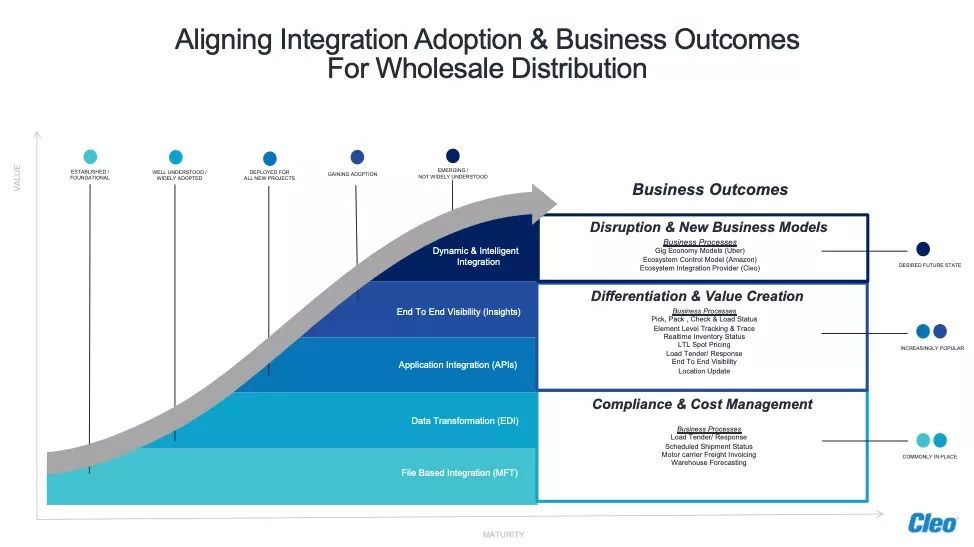Blog
Wholesale & APIs, What is the Added Value?
While EDI is a proven technology which is efficient and has low costs, it can't keep up with every trend the market faces. Here's where API's come in. For wholesale distribution businesses to transform themselves into digital enterprises, they need to adopt API-based integration.

If we look at wholesale today we can't ignore the fact that a good integration technology is fundamental for their Supply Chain agility and distribution software. But if we look under the hood we are sure to find some missing parts to really drive the companies growth to the next level. That's because most wholesale companies rely on standard technology for integration with customers, suppliers and logistic companies through EDI. While EDI is a proven technology which is efficient has low costs, it can't keep up with every trend the market faces. Here's where API's come in. For wholesale distribution businesses to transform themselves into digital enterprises, they need to adopt API-based integration.
What’s more, to become a digital business that can proactively anticipate and shape demand, deliver e-commerce capabilities, and exceed customer expectations for real-time visibility and inventory management, they need APIs that deliver real-time information, just like a modern dashboard in a powerful Tesla.
Below are the top five areas where API integration can create economic value for wholesale distributors.
1. Rapid Onboarding
Sales and IT teams need an integrated strategy for seamless onboarding of business customers as well as their end users. In today’s competitive world it takes a lot of effort and time for sales and marketing to land a new customer, and there is a finite window when there is an opportunity to onboard the new customer and scale volume business. Yet, many operations and IT teams miss that window due to slow onboarding processes with rigid (often manual) technologies. As a result, newfound relationships can get off on the wrong foot.
An API integration platform with seamless integration capability to back-office applications plus the ability to consume orders from customer systems (as well as EDI orders when that is the mandated approach from the customer; EDI is really a subset of API management these days) can enable onboarding in hours or days instead of several weeks.
2. Order-to-Cash Enablement
The entire EDI processes for receiving purchase orders (ORDERS), providing advance ship notices (DESADV), invoices (INVOIC), and all the associated acknowledgements can be replaced by two-way direct communication with APIs from modern ERP systems that can be integrated via an the right solution. APIs can also enable real-time inventory status information which is becoming increasingly valuable for B2B customers.
3. End-to-End Visibility
Who doesn't want End-to-End visibility? While EDI comes pretty far, APIs can boost that to 100% real-time transactional visibility for all orders, invoices, and inventory statuses for customers. Further, APIs can integrate with visibility platforms and provide real-time update on location and route tracking information.
4. E-Commerce API and Omnichannel Enablement
Omnichannel are becoming more important for Wholesale and for Retail. But how do you deliver the complete digital experience for E-commerce and Omnichannel enablement? Standard MFT or EDI solutions won't be sufficient to make sure you stay competitive, APIs can provide you just what you need. From ecommerce API integrations to product catalogs, ERP, warehouse management, and inventory management systems, customers can get complete access to product information, order tracking, inventory status, location updates, and ability to buy anywhere (online or store) and fulfilled anywhere (store or direct to consumer).
5. Back-End Application Integration
APIs are providing a lot of new opportunities but can also be used to to seamlessy integrate back-end applications (SaaS and Legacy) into a digital order-to-cash and/or procure-to-pay process. APIs goes even beyond with the ability to extract in real-time up-to-date product pricing, product details, order tracking, and real-time inventory information to enable digitalization of supply chain processes.
An API SaaS platform also allow a new level of customizability. As an example, a SaaS application may not have the exact interface needed for a given wholesale distribution business case, but, by leveraging API based integration capabilities, a customized extension to support the required business case can be efficiently developed and deployed.
Get back in the driving seat!
From this it should clear that for companies in the wholesale distribution to truly jump in the driver’s seat they need an ecosystem integration vision, strategy and plan. No matter where you begin (i.e., no matter what integration solution is “under the hood” at your company the moment), an API-first strategy will best help you cruise into the future, and maneuver around bumps in the road.
Cleo has been driving this vision for some time and combining their solutions with our knowledge we can get you in the driving seat, show you how to maximize your performance and tackle every challenge you might face in the future! If you want to keep ahead of your competitors and achieve extra flexibility contact us today to explore your possibilities.



